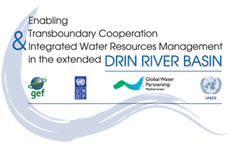Lake Ohrid
Because the lake has been isolated by surrounding mountains, a unique collection of plants and animals have evolved; some of these are now considered relics or “living fossils” and can be found only in Lake Ohrid. Lake Ohrid area has been a UNESCO World Natural Heritage Site since 1980. The lakeshore reedbeds and wetlands provide a critical habitat for a high number of wintering water birds, including rare and threatened species.
Pressures, transboundary impacts and responses
Human interventions have altered the hydrological regime of the lake. The diversion of the Sateska River in the former Yugoslav Republic of Macedonia into the lake increased its watershed area, and consequently the agricultural run-off and sediment input. Sediment loads have also increased, due to unsustainable forest management and subsequent erosion, causing destruction of wetlands in parts of the lake in both countries. Reforestation activities in the former Yugoslav Republic of Macedonia have resulted in an improved situation in this regard.
Water from the lake and its tributaries is used for irrigation and drinking water supply.
Unsustainable agricultural practices exert pressure, leading to pesticides and nutrient pollution. A lack of, or inadequate municipal wastewater management and sewerage leakages, have an equally important share with regard to nutrient loading in the lake, and exert minor pressure on the underlying Prespa and Ohrid Lakes karst aquifer. Sewage from Pogradec (Albania) has been a major contributor of phosphorus and organic load. The newlybuilt collection and treatment facilities, which allow treatment of the wastewaters of some 25,000 inhabitants, with further stages planned, are expected to improve the situation. They will also reduce the levels of faecal pathogens. Reduction of pollution from municipal wastewaters has been achieved in the former Yugoslav Republic of Macedonia’s side of the lake, where a sewerage system was constructed that collects wastewater from shoreline communities; treating about 65% of wastewater of the Ohrid – Struga region (in the Black Drin catchment) in a plant with a capacity of 120,000 p.e. and discharging it in the Black Drin. There are plans for the construction of additional systems in the area.
Untreated wastewater discharges from industrial activities in Pogradec (food processing, textile, metal and wood processing and other light industries) are considered to be a significant source of pollution.
Uncontrolled waste disposal in the watershed might be a cause of groundwater, hence lake, pollution. Both countries are planning to take necessary action to address the problem. The National Strategy for Waste Management in the former Yugoslav Republic of Macedonia provides for a regional landfill that will cover the needs of the Prespa and Ohrid areas; this will be constructed outside the boundaries of the respective sub-basins.
The commercially important fish species in Lake Ohrid, including the famous Lake Ohrid trout, have been over-harvested in recent years, and the populations are in immediate danger of collapse. Fish in the lake must be managed collectively, with similar requirements in the riparian countries. Fish hatcheries have been set up by both countries. Albania has also taken some measures to limit illegal fishing. The alteration of the reed zones has caused deterioration of habitats, also threatening the spawning and wintering grounds of fish species.
A spatial plan for the areas of Ohrid and Prespa has been prepared in the former Yugoslav Republic of Macedonia.
Transboundary cooperation
The two countries have harmonized procedures for water quality monitoring in the Lake and its tributaries, including developing Joint Protocols for sampling, analyzing and quality assurance in the framework of the GEF Lake Ohrid Conservation Project (ended in 2004). Three hydrological stations exist in the territory of the former Yugoslav Republic of Macedonian, while the Hydrobiological Institute monitors the lake’s system for biological and chemical quality.
The development of a “Transboundary Watershed Management Plan” was prepared under the GEF project and endorsed in October 2003, but restricted resources have had an impact on its implementation.
The 2004 Agreement for Lake Ohrid and its Watershed between the two countries was a major step towards the sustainable management of the lake and its basin; the Lake Ohrid Watershed Committee was created and empowered with legal authority in both countries. Three Working Groups of experts, on Legal framework, Fisheries and Management plan preparation were established in September 2008 under the Committee, having as their main duty to assist in the harmonization of related pieces of legislation in the two countries.





